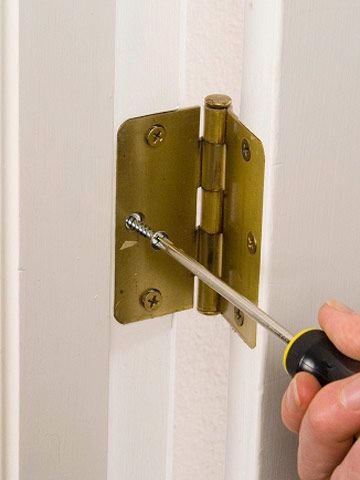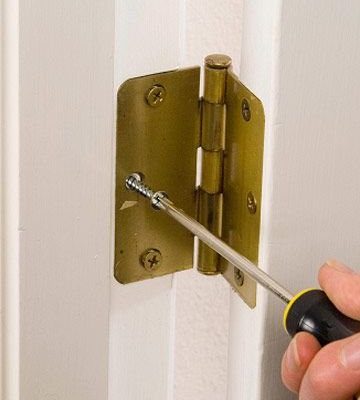
Here’s the thing—a hinge may seem like a small part, but it plays a huge role in keeping your door perfectly lined up and sealed. When a hinge is loose, bent, or even out of alignment by a hair, it can pull the door out of place and leave a gap for cold air to sneak through. I’ve seen this happen with all sorts of doors, from classic wooden ones on old craftsman homes to tough, insulated models that use heavy-duty Kwikset or Schlage hardware. No matter the brand or style, a fussy hinge will let a draft in.
Let me explain exactly how hinges cause those pesky drafts, and how you can fix it—even if you’ve never swung a screwdriver in your life.
How Door Hinges Cause Drafts
It might seem surprising, but a misaligned or damaged hinge can be the main reason your exterior door isn’t sealing out the cold. Doors need to sit flush against the frame for the weatherstripping to work. If a hinge is out of sync, even by a tiny bit, it can pull the whole door out of alignment.
Think about it like a puzzle piece that only fits one way. If one edge is off, the whole thing doesn’t connect properly. Same with your door—misaligned hinges mean uneven gaps, and those gaps are just an open invitation for drafts.
Here’s how it usually happens:
- The screws in the hinge loosen over time from opening and closing the door.
- The hinge itself warps, bends, or gets rusty—especially on older doors or those exposed to the weather.
- The door frame shifts slightly, causing the hinge plate to pull out of position.
You might not notice anything at first. But pretty soon, you hear the wind whistling or feel a cold edge as you pass by. If you spot visible gaps or daylight leaking around the hinges, you’ve found your draft source.
Signs Your Door Hinge Is the Culprit
You might be wondering—how do you know it’s the hinge and not something else? The clues are usually right in front of you, but they can be subtle.
Watch for these signs:
- You see a gap between the door and the frame near the hinges, especially at the top or bottom, but not all along the edge.
- The door feels uneven or wobbly when you open or close it, or it “sticks” in spots.
- You can see movement in the hinge when you push or pull on the door—loose screws are a red flag.
- There’s a visible draft or even a sliver of daylight sneaking around the hinge side.
Honestly, if you’re dealing with an older door or one that’s been through a few winters, these issues pop up more often than you’d think. Sometimes, even brand-new doors from trusted brands (like Andersen or Pella) can develop hinge problems if they weren’t installed just right.
Troubleshooting starts with a careful look—and a gentle push and pull at each hinge to spot any wiggle or gap.
Tools You’ll Need to Fix a Drafty Door Hinge
Before you dive in, let’s talk about what you’ll need. Good news—most hinge fixes are DIY-friendly and don’t require fancy gear. If you have a basic toolkit, you’re halfway there.
Here’s a short list:
- Phillips and flathead screwdrivers (for most hinge screws)
- Replacement screws (wood or metal, depending on your frame)
- Wood filler or toothpicks (for stripped screw holes)
- Hammer (sometimes needed to tap the hinge pin)
- Level, to check door alignment
- Lubricant (like WD-40) if hinges are rusty or sticky
If you’re working with specialty hardware (think mortise hinges, ball bearing hinges, or concealed hinges from brands like Emtek or Baldwin), double-check your tools to match the specific screws or pins. Honestly, most houses just use standard butt hinges, so you probably won’t need anything wild—but it’s good to be prepared.
Step-by-Step: Tightening and Realigning Your Door Hinge
Fixing a loose or out-of-alignment hinge is more about patience than brute strength. Here’s a straightforward, step-by-step approach:
1. Tighten Hinge Screws
- Open the door and locate the screws on the hinge plate (both on the door and frame).
- Use your screwdriver to snug each screw firmly. If a screw just spins or feels loose, the hole may be stripped—don’t panic, we’ll get to that.
2. Check Door Fit
- Once tightened, close the door and look for gaps. Run your hand along the edge. If you still feel a draft, move to the next step.
3. Reposition the Hinge
- If the gap is wider near one end, try loosening the screws, nudging the door gently, and retightening. A door that sags may need the top hinge moved up slightly or the bottom hinge adjusted down.
4. Fix Stripped Screw Holes
- If screws won’t tighten, pull them out and fill the hole with wood filler (or jam in wooden toothpicks coated in wood glue). Let it dry, trim flush, then put the screw back in—it should grip much better.
Move slowly and check your progress as you go. Sometimes it takes a bit of trial and error, but you’ll feel the difference as soon as the door closes snugly.
When You Need to Replace the Hinge Completely
Sometimes, all the tightening in the world won’t fix a drafty door hinge. If the hinge itself is bent, warped, or heavily rusted, it’s time for a replacement.
Here’s what to watch for:
- The hinge plates are visibly bent out of shape or don’t sit flat against the door and frame.
- There’s excessive rust, cracking, or the pin won’t come free.
- You’ve already tried tightening, but the draft won’t go away and movement is obvious at the hinge.
If that sounds like your situation, don’t stress. Most hardware stores have replacement hinges that fit standard doors (3.5 or 4 inches for most exterior models). Bring the old hinge with you if you’re unsure about size or style. Matching the screw pattern really matters—otherwise, you’ll have to drill new holes, which isn’t ideal for beginners.
Once you’ve got the new hinge, just reverse the steps you used to remove the old one. If you’re swapping out all hinges on a heavy door, support it with a wedge or have a friend help you, so it doesn’t drop off the frame.
What If the Draft Isn’t Fixed After Hinge Repair?
Okay, so you’ve tightened, adjusted, maybe even replaced the hinge—but you’re still feeling a draft. Don’t give up yet! Sometimes the problem is a combination of issues, not just the hinge alone.
Common reasons drafts can linger:
- The weatherstripping is old or damaged and needs replacing.
- The door is warped or swollen from moisture—common with wood in wet climates.
- The frame itself is out of square due to settling or foundation issues.
- You have a misaligned threshold or uneven flooring that’s throwing things off.
If you’ve taken care of the hinge but the draft persists, check each of these areas step by step. Sometimes a new piece of weatherstripping or an adjustable threshold does the trick. And if your door still won’t seal? That could be a sign you need a professional’s help, especially if you suspect structural shifting.
If you’ve fixed the obvious, but the draft remains, it’s not a sign you did something wrong. Exterior doors deal with a lot—weather, time, shifting homes—so think like a detective and tackle each part, one at a time.
Comparing Hinge Fixes to Other Draft Solutions
You might be wondering—should you bother with the hinge, or would it be smarter to look at other fixes first? Here’s how hinge troubleshooting stacks up:
Why start with hinges? They’re often the quickest, cheapest fix. Tightening a screw or swapping a $5 hinge usually beats out replacing an entire door or frame.
Alternative solutions:
- Weatherstripping: Great for smaller gaps, but useless if the door isn’t aligned.
- Door sweeps: Help at the bottom, but not at hinge-side gaps.
- Threshold adjustments: Useful if the gap is at floor level, but again, only works if everything else lines up.
- Full door replacement: Necessary only if the door or frame is warped beyond repair—rare, and usually a last resort.
Here’s what I always say: Start simple and cheap, and work your way up. In my own old house, a screwdriver and a handful of toothpicks fixed a draft that a pro quoted at $500 to “remedy.” So don’t skip the basics.
Pro Tips for Keeping Exterior Door Hinges Trouble-Free
Once you’ve fixed your draft, you probably want to make sure it stays gone. Luckily, keeping door hinges in shape doesn’t take much work.
Here’s what works:
- Check hinge screws every few months—snug them up if they feel loose.
- Add a drop or two of lubricant to keep things moving smoothly, especially if you notice squeaks.
- Wipe away rust or gunk as soon as you spot it. A little maintenance now beats a big project later.
- If your door is hit by heavy weather, consider upgrading to corrosion-resistant hinges—they last longer and resist sticking.
Just like a car needs the occasional oil change, your exterior doors need a quick once-over now and then. A minute spent now saves you from winter drafts and high bills later.
Wrapping Up: Beat Drafts at the Hinge
A drafty door can make your whole home feel less cozy. The humble hinge is often the hidden cause, but it’s also one of the easiest things to check and fix—even for a total beginner. Start with a screwdriver and a patient eye, and work through the steps one by one. In most cases, a firm hinge is all it takes to slam the door on those chilly drafts.
If the problem proves stubborn, just remember—sometimes it’s a team effort between hinges, weatherstripping, and the door itself. Stick with it, and you’ll keep your home warm, efficient, and comfortable, no matter what the weather brings.
